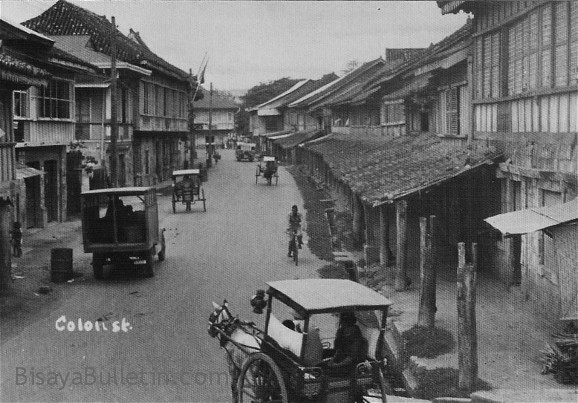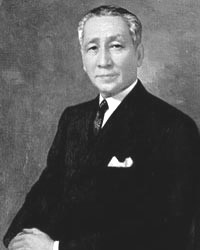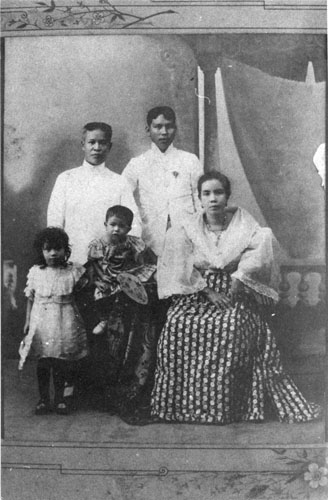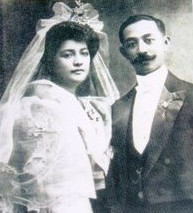Colon's Prominent Residents
Contributed by Kiting Moro & Fred Umabong
November 30, 2008
During the late 19th century, Colon was first and foremost a street full of residential houses built in rows. For every store, shop and office on the ground floor, there was a family or two living upstairs. Some came from the most prominent families of their time and ours, others from once-prominent families now long forgotten, having moved out of Cebu, their descendants scattered all over the archipelago and abroad.
From the Colon section of Parian lived the Gantuangcos, whose descendant, Concepcion Gantuangco-Briones, wrote in 1980 an important first-person account of life in the old Parian district. The Gantuangcos lived on No. 66 Colon Street. Across the house lived the Lu. Do Family, whose children Paterno and Cayetano, would later make a name in the coconut oil manufacturing industry in Asia. It was here that Lu Do (or Oya Owa), who came from Amoy, China, built a copra-buying station on property leased from Fr. Venerado Reynes in 1896.
On this same row lived the Rallos family led by patriarch Florentino Rallos, who became Cebu's Municipal President (Mayor) in 1907-08. The Rallos property was said to straddle the Parian Estero up to Manalili Street. Up until World War II, the family had kept an old caruaje, an heirloom piece at their Colon residence.
On the same row also lived the Osmeñas and the Singsons. The shipping office of Don Victoriano Osmeña was on the ground floor of this big stone house, which had two main doors – one opening to Colon, the other to the dark and narrow Sudlon Street. At the corner of Colon and Norte America (now D. Jakosalem) was the stone camarin and bodega of Don Tomas Osmeña, with a yard so big that it occupied an entire block. Don Sergio Osmeña, meanwhile, lived still farther, along the corner of Colon and Pelaez streets, where he had his law office on the ground floor. It was also here that Cebu's first daily, El Nueva Dia, which he published, had transferred from Calle Comerio (later M.C. Briones).
Don Mariano Albao Cuenco, a lawyer from Carmen, Cebu came to Colon in the 19th century and built an imposing house located between the corners of D. Jakosalem and Mabini. Its ground floor later became the office of the Imprenta Rosario, a printing press founded by Cuenco in 1907 and taken over by his wife, Doña Remedios, who became the first woman publisher I Cebu. The printing press published, among others, the revived El Boletin Catolico in 1915, Cebu Daily News in 1923, and the English-language newspaper Republic News. The politically prominent Cuencos continue to own the property today.
During the first decade of the 20th century, the ground floor of Don Agapito Garces' house at the corner of Mabini and Colon streets served as venue for early films. Another Garces, Doña Josefa, owned another property along Colon around 1914.
Farther along the old part of Colon lived Don Victorino Reynes, foremost realtor, art collector and a famous philatelist. Don Victorino owned a shop at his residence o No. 86 which was across Teatro Oriente. At the junction of Legaspi and Colon lived the prominent theater owner Don Jose Avila. Near this house, the Estero of Parian tapered off and vanished.
Across the Los Hijos de Pueblo clubhouse on the corner of D. Jakosalem lived Don Esclastico "Capitan Tikoy" Veloso, whose hose once served as office of the Real Audiencia. The ground floor was later converted into a shop where stagecoaches were made and repaired. Beside the Hijos clubhouse was the residence of the Martinez-Franco clan, with its ground floor hosting a busy foundry for making cawa (cauldrons). Don Domingo Franco owned the house together with his wife, Doña Lucia Chiong Veloso and her sister, Doña Charing Veloso-Martinez.
At the corner of the Junquera and Colon lived Don Mamerto Escaño whose family originally hailed from Leyte. Increasing investment exposures in Cebu forced the Escaños to establish a foothold in Cebu. Like all the rest, the family made the most logical choice – Colon.



